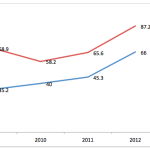 December in Boston means Patriots football, Bruins hockey, Celtics basketball, and snow. Two snowfalls this week have made my backyard a snow sandwich, 6 inches of snow and 8 inches of snow with an inch of ice in the middle. The good news is that Boston knows snow. The streets are plowed before dawn and life goes on uninterrupted. The bad news is that we will not see a blade of grass again until April.
December in Boston means Patriots football, Bruins hockey, Celtics basketball, and snow. Two snowfalls this week have made my backyard a snow sandwich, 6 inches of snow and 8 inches of snow with an inch of ice in the middle. The good news is that Boston knows snow. The streets are plowed before dawn and life goes on uninterrupted. The bad news is that we will not see a blade of grass again until April.
I’m sure that snow makes some people think of skiing and ice skating, but this week snow has made me think of SNOMED…nerdy, I know. I have known about SNOMED as a standard set of clinical terms, but have been curious about it lately since it seems to come up often in discussions about Stage 2 Meaningful Use (MU2).
A fresh blanket of terms
The Systemized Nomenclature of Medicine – Clinical Terms or SNOMED-CT is a collection of clinical terminology organized systematically into a hierarchy that shares a common language with other international standards. SNOMED-CT has 4 components—Concept codes, Descriptions, Relationships, and Reference Sets—and over 300,000 concepts, each of which may have multiple relationships.
For example, the concept of viral pneumonia may have relationships to lung diseases and also infectious diseases. The descriptions associated with a concept are specific phrases such as, “viral upper respiratory tract infection.” The taxonomy and hierarchical structure of SNOMED is interesting and there is a lot of information about it online.
The start of the SNOMED age
This compulsive exactness of SNOMED-CT is not surprising given its roots. SNOMED-CT began in 1965 as the Systematized Nomenclature of Pathology (SNOP). In 1999 SNOMED-CT was created by combining SNOMED Reference Terminology (SNOMED-RT) from the College of American Pathology (CAP) and Clinical Terms Version 3 (CTV3) from the National Health Service in the UK. Since release in 2002, SNOMED-CT has had wide international use and is considered the “…most comprehensive, multilingual clinical healthcare terminology in the world.” In 2007 SNOMED-CT became the intellectual property of the International Health Terminology Standards Development Organization (IHTSDO), which now oversees maintenance, ongoing development, quality assurance, and distribution of the SNOMED-CT product. SNOMED-CT crossmaps to ICD-9, ICD-10, and LOINC and enables HIE by complying with recognized international standards including ANSI, DICOM, HL7, and ISO.
Skating along with MU2
It turns out that SNOMED-CT has a big role in MU2 as a crosswalk from ICD-9 to ICD-10. SNOMED captures detailed clinical terminology that clinicians recognize as pertinent to patient care like pneumococcal pneumonia of the right lower lobe, a specific organism causing pneumonia in a particular part of the lung. This is part of the data input that occurs in patient care. ICD codes are for data output for billing, research, or epidemiology, with the assignment of a diagnostic or procedural code. SNOMED CT and ICD share standard definitions and a common language. This way if patient diagnoses can be expressed in SNOMED CT, then they can be translated into ICD-10.
Today’s forecast
In the U.S. many EHRs are utilizing SNOMED-CT to ease the transition from ICD-9 to ICD-10. SNOMED-CT is available through the National Library of Medicine Unified Medical Language Systems (UMLS) for this use at no cost, as the National Library of Medicine on behalf of the department of Health and Human Services has purchased licensure to the information.
When I first started private practice in 1989 I remember the notes in the paper chart from the retiring nephrologist I replaced. They were often 3 handwritten lines:
BP check today
No change in meds
RTC in 3 months
For a single nephrologist following a single patient in 1989, this note worked fine, but it is an ice age from the documentation required today for billing and coordinated care team management of complex chronic diseases.
Today, as we document clinical findings, symptoms, diagnoses, procedures, organisms, etiologies, detailed medications for continuity of care, and reimbursement, SNOMED-CT functions as a clinically relevant, detailed, and systematic tool.
When I grew up in Florida wearing shorts and flip-flops in December, I never thought I would live someplace like snowy Boston, but here I am. Before I get SNOMED-ed in, I’m going to put on my boots and head out for a walk in my own winter wonderland.




Leave a Reply